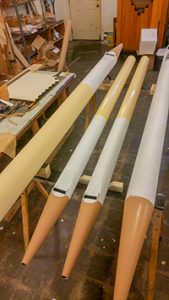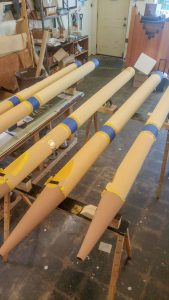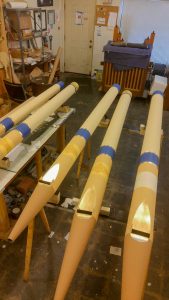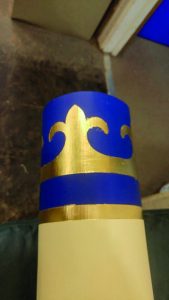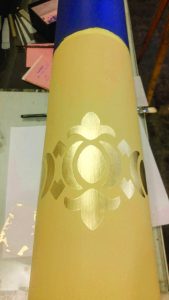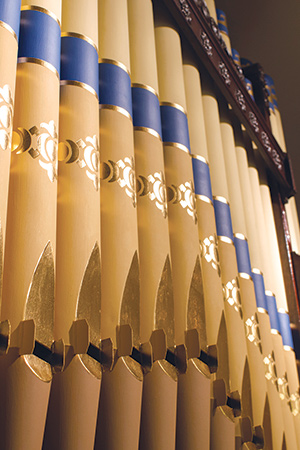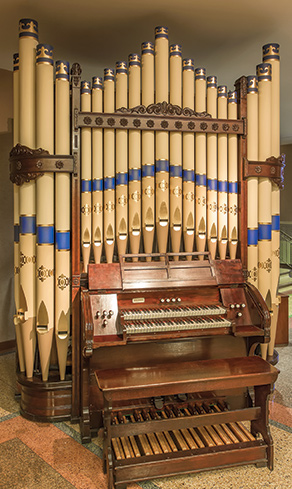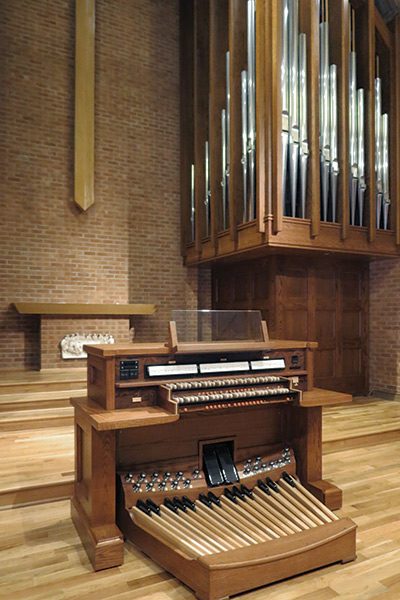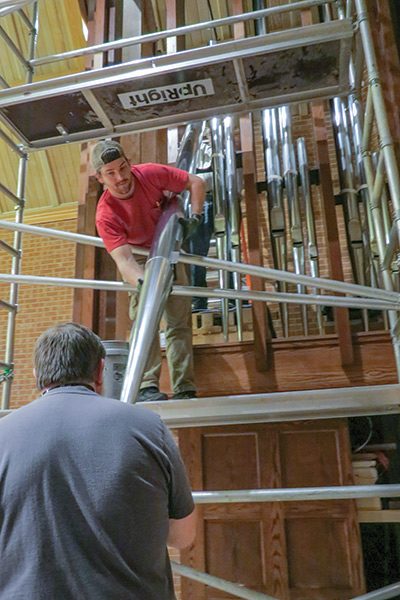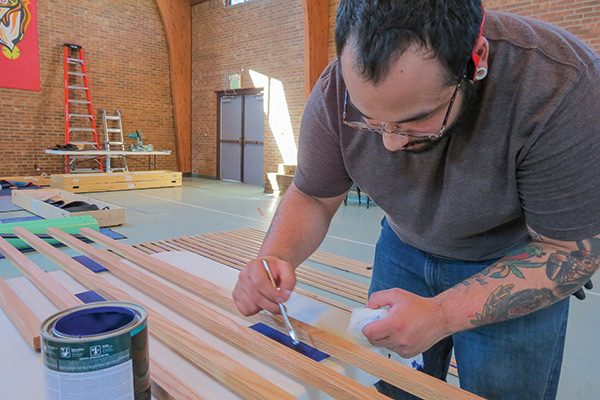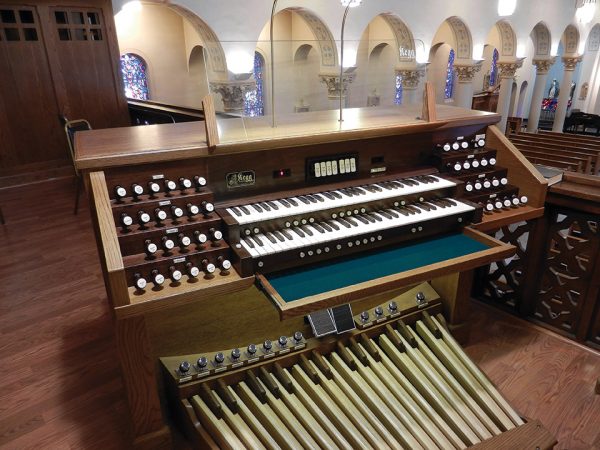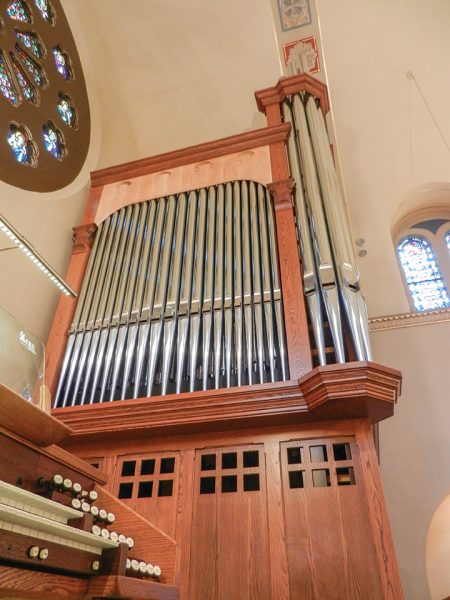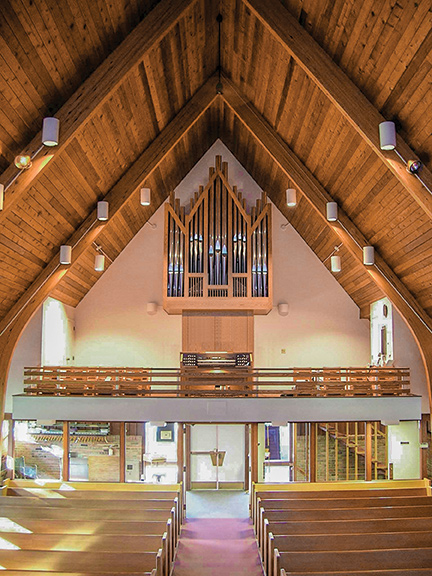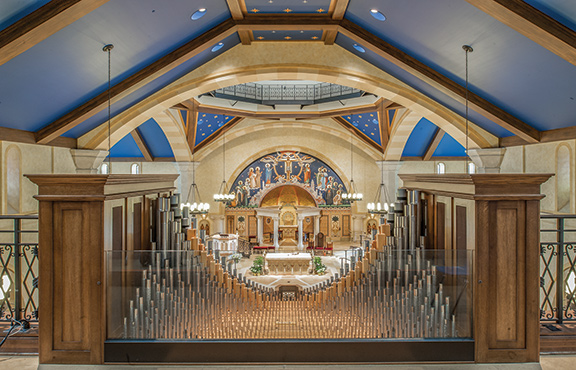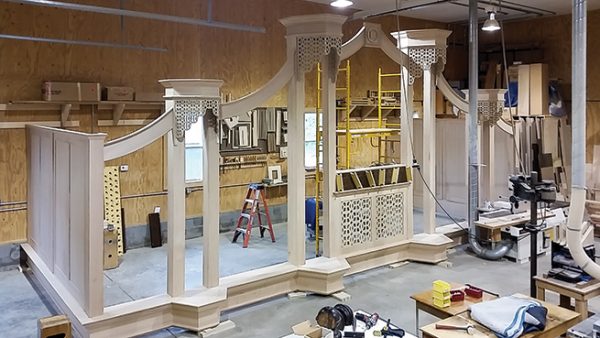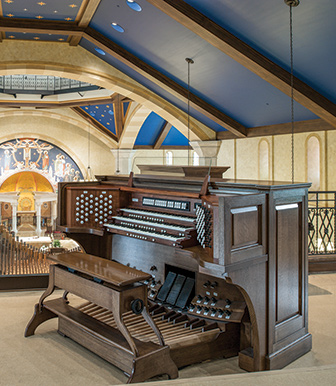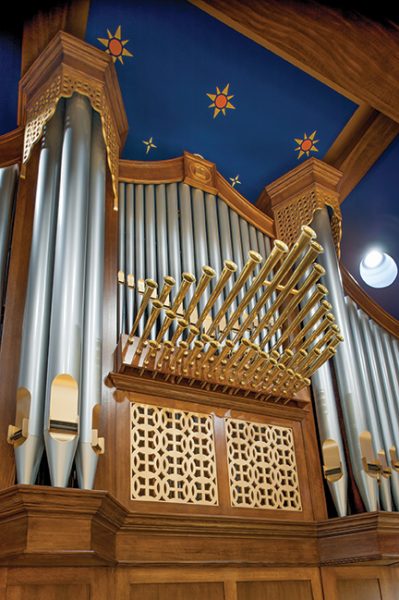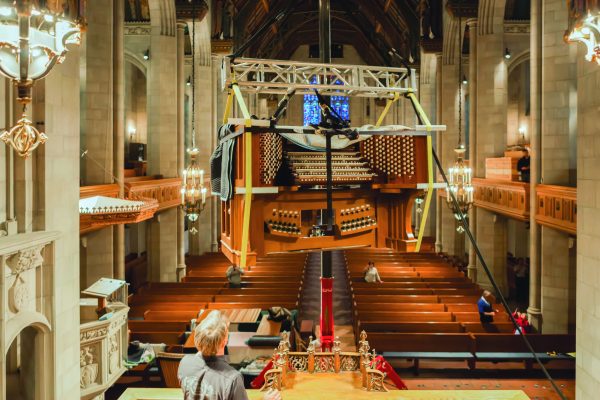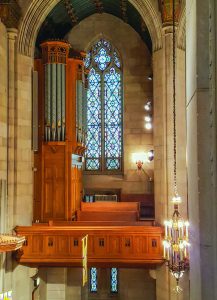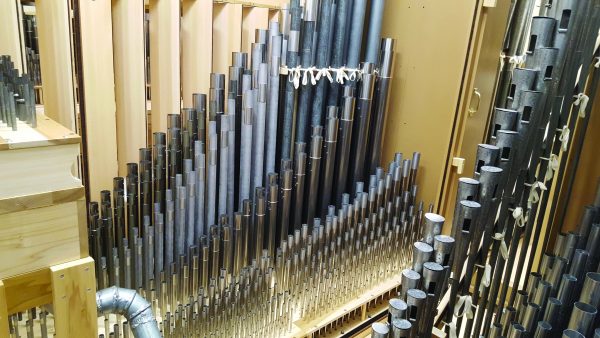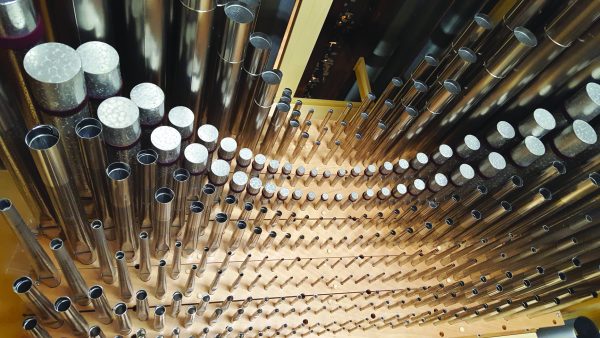Emmanuel Episcopal Church
Southern Pines, N.C.
C.B. Fisk, Inc. • Gloucester, Mass.
by David C. Pike
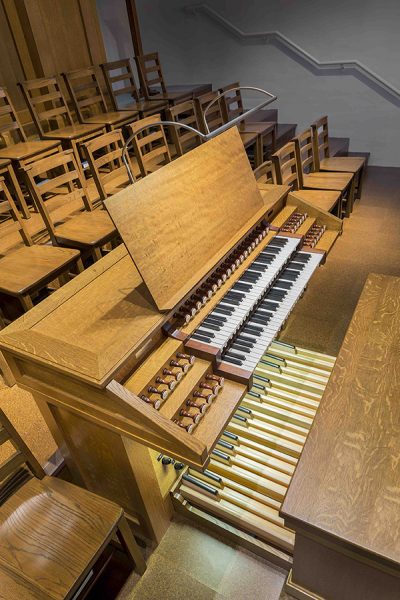 At Fisk, our mission is not only to build superb musical instruments, but also to be collaborative partners in all aspects of a project, to ensure the best and most practical musical solutions for our clients.
At Fisk, our mission is not only to build superb musical instruments, but also to be collaborative partners in all aspects of a project, to ensure the best and most practical musical solutions for our clients.
In December 2013, our firm was formally commissioned by Emmanuel Episcopal Church of Southern Pines to build a new mechanical-action pipe organ for the church sanctuary. The signing of a contract represented a true milestone after several years of brainstorming and in-depth discussion between Emmanuel’s organist and choirmaster Homer Ferguson III, church governance, and members of the Fisk team. For a time, church leaders had considered building a new, larger sanctuary, but, in the end, the expense involved was deemed prohibitive. It was then generally assumed that the new organ would be placed in the existing sanctuary’s west gallery, where the previous organ, along with the choir, had lived for many years. As cramped as this arrangement was, it was what people had grown accustomed to and was consequently what was expected. At the Fisk workshop, as part of the organ’s visual design process, a scale model of the existing space was built to explore various possibilities for siting the organ. Within this model, we developed a new plan that would gain many of the desired benefits of a new building, but at a fraction of the cost. The organ and choir would move to the front of the sanctuary, and they would inhabit a newly constructed gallery above and behind the central worship area. In order to accommodate the height of the organ case, and to add more depth and loft to the front of the nave space, two bays of the church roof would be raised. The new scheme gained additional seating for the congregation and sufficient space and improved acoustical support for both organ and choir. A redesigned chancel allows the removal of the reredos during organ recitals and accommodates the church’s many secular musical events.

Construction of the new instrument began in our Gloucester workshop in spring 2014, and Opus 145 was completely assembled and playing in time for an April 2015 open house. Several Emmanuel parishioners made the trek north for the occasion. Describing the experience, Dr. Ferguson later wrote “. . . Saturday was one of the most fulfilling days of my life. Years of dreaming and planning, hoping and praying, had all come into focus . . . Seeing the delicate details of the new keyboards, feeling the swiftness and connectedness of the action, hearing such sweet, vocal tone from the handcrafted pipes, was a sensory nirvana.”
Opus 145 is the 13th pipe organ installation in North Carolina by C.B. Fisk. When fully realized, the organ will total 35 stops and 2,135 pipes distributed over two manuals and pedal. Though visually and mechanically complete, the organ still lacks eleven of its stops and approximately 842 pipes; these will remain unbuilt until funding is obtained.
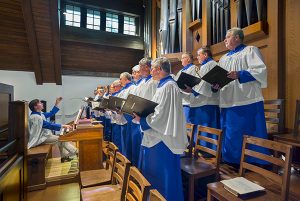
The mechanical design of a tracker organ must be as simple as possible in order to increase the organ’s utility and reliability, and to allow an unfettered transmission of musical expression. Our experience with creating light, responsive actions and our increasing use of materials such as carbon fiber have allowed us to reach a new standard of key-action touch with Opus 145’s detached console.
Opus 145 contains two notable “firsts” for C.B. Fisk, both of which were ardently put forward by Dr. Ferguson. Firstly, the Great division is partially enclosed in an expression box. Outside the box and just behind the facade are the pipes comprising the Great plenum. The remaining three 8′ foundations, the Flute 4’´, and both reeds live inside an enclosure in “Hinterwerk” position. This feature offers the organist considerable flexibility in leading and accompanying all aspects of Episcopal liturgies, and, in conjunction with a well-appointed combination action from Solid State Organ Systems, offers many of the advantages of a three-manual instrument. Secondly, a Swell to Great Super coupler was engineered into the key action, which gives the player yet one more practical tonal resource and makes possible sonorities that otherwise would not be obtainable.
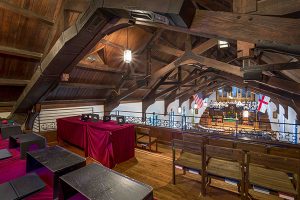
On behalf of the artisans of C.B. Fisk, I wish to thank the people of Emmanuel Church for the opportunity to build a new mechanical-action pipe organ in their beautiful sanctuary. Without the constant support and hospitality of Homer Ferguson, the congregation, the organ and building committees, and the staff, the pursuit of our art and our sojourn in Southern Pines wouldn’t have been nearly as rewarding.
David C. Pike is executive vice president and tonal director of C.B. Fisk Inc.
From the Organist and Choirmaster
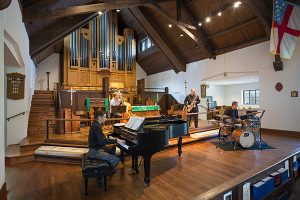
I began my tenure as organist-choirmaster at Emmanuel Episcopal Church in August 2010, following 25 years of the strong musical leadership of Alan Reed and Johnny Bradburn. The church was on the brink of an exciting capital expansion that promised a new sanctuary, a new office wing with a complete music suite, and a new pipe organ.
Upon my arrival, I found a fully carpeted church equipped with Wicks Opus 5896 (1982) crammed into a confined rear gallery. This organ had originally been conceived as an interim instrument when it replaced M.P. Möller Opus 7616 (1947), located in a side installation at the front of the church. As the years progressed, alterations and additions enabled the Wicks to better serve the growing church, but by the mid 2000s it had become increasingly unreliable. The windchests were located near the floor of the loft, and pipes spoke directly into the ears of choristers. It was time for a fresh start.
Initially, the situation was not of great concern, as a new church building would remedy many of these challenges. However, by the end of 2011, a weak economy and a deep attachment to the original 1926 building upended plans for a new church. As it was now clear that the parish would continue to use its historic sanctuary, a plan was developed to replace the organ, presumably in some reconfigured rear gallery scenario.
A committee was formed to investigate the possibilities. While they explored several solutions, mechanical action became an early focus. This inspiration was several-fold. Firstly, the committee did not want the church to face an organ replacement in another 30-plus years as it had done twice before. Secondly, there were no mechanical-action pipe organs in all of Moore County, leaving a pedagogical void for aspiring young organists. Furthermore, a mechanical-action organ would add diversity to the cultural fabric of our region.
The selection of Fisk began a collaborative effort involving not only some of the greatest creative minds in organbuilding, but also the work of acoustician Dana Kirkegaard and organ and liturgical designer Charles Nazarian. Their combined efforts realized a plan for a new instrument that not only fulfilled the musical needs of the parish, but also created a visual statement that brought focus to the chancel. The result is an instrument of great beauty, something I firmly believe is an attribute of God.
Opus 145 has invigorated our congregational singing. It assists our all-volunteer choirs in offering anthems that illuminate our Biblical texts. It whispers musical prayers and it declares our statements of faith. It serves as a musical teacher through its responsive, living action and spins musical line with authenticity. For performer, worshipper, and concert attendee, this instrument can induce a state of euphoria.
I want to personally thank everyone who has been involved in this project. It was only because of the combined efforts of the leadership at Emmanuel Episcopal Church, the parishioners, friends, and community members who believed in the worth of this endeavor, and the artisans at C.B. Fisk, that this instrument was realized. It is important to note that more than 300 families and individuals funded this new pipe organ. This was truly a community effort.
The organ was dedicated in a Festival Choral Evensong on May 15 with Alden Wright and myself sharing the console, the Emmanuel choir, and Johnny Bradburn, choirmaster emeritus. A new choral anthem commissioned for the occasion, “God Moves in a Mysterious Way” by Philip Stopford, was premiered, as was a new hymn, “Alleluias Roar Through Organs” by Paul Chappel. A dedicatory summer recital series, Fridays on the Fisk, celebrated the new instrument with four separate recitals by North Carolina organists Homer Ferguson III, André Lash, Chase Loomer, and Stephen Gourley. The hands of the men and women of C.B. Fisk have shaped wood and metal into an American musical masterpiece. It is sacred art in its highest form. My greatest hope is that this instrument will serve to the glory of God for centuries. May those who marvel at it always be reminded of its purpose as a tangible statement of faith.
Homer Ashton Ferguson III

